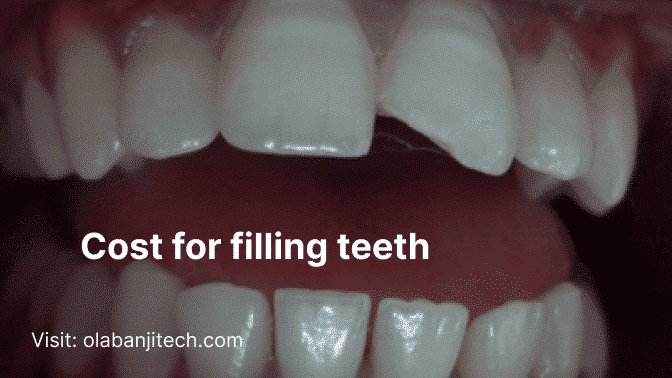teeth fillings are a common procedure used to treat cavities and tooth decay. When bacteria eat away at the enamel of a tooth, a hole or cavity forms. If left untreated, this cavity can grow, causing pain and infection. teeth fillings help restore the damaged tooth by filling in the hole and preventing further decay.
Types of Teeth Fillings
There are several types of teeth fillings, including amalgam, composite, ceramic, and gold. Amalgam fillings are made of a mixture of metals and are durable, making them a popular choice for back teeth. Composite fillings are made of a tooth-coloured resin material and are more aesthetically pleasing, making them a popular choice for front teeth. Ceramic and gold fillings are less common but are sometimes used in special cases.
Here are the types of teeth fillings which includes:
- Amalgam Fillings: Amalgam fillings are made of a mixture of metals, including silver, tin, copper, and mercury. They are strong, durable, and long-lasting. Amalgam fillings are often used on molars or other teeth that are not visible, as they are silver in colour and can be noticeable.
- Composite Fillings: Composite fillings are made of a tooth-coloured resin material that blends in with the surrounding teeth. They are a popular choice for front teeth, as they are more aesthetically pleasing. Composite fillings are not as durable as amalgam fillings and may need to be replaced more frequently.
- Ceramic Fillings: Ceramic fillings are made of porcelain and are also tooth-coloured. They are more expensive than other types of fillings but are more durable and long-lasting. Ceramic fillings are a good choice for patients who want a more natural-looking filling.
- Gold Fillings: Gold fillings are made of a mixture of gold, copper, and other metals. They are the most durable and long-lasting type of filling, but they are also the most expensive. Gold fillings are often used on molars or other teeth that are not visible.
Factors that Influence the Cost of Teeth
Fillings
Several factors can influence the cost of teeth
fillings, including:
- The type of filling material used
- The size and location of the cavity
- The dentist's level of experience and expertise
- The geographic location of the teeth
practice
Average Cost of teeth Fillings in Different Regions/Countries
The cost of teeth fillings can vary widely depending on the region or country in which the procedure is performed. In the United States, the average cost of a teeth filling can range from $150 to $500 per tooth. In other countries, such as Mexico and Costa Rica, the cost can be significantly lower, with fillings costing as little as $30 to $50.
Insurance Coverage for teeth Fillings
Most teeth insurance plans cover the cost of teeth fillings, at least in part. However, the amount of coverage can vary depending on the plan and the type of filling material used. Patients should check with their insurance provider to determine their coverage and any out-of-pocket costs.
Read Also: Are Efero teeth whitening safe, (What is the use of Efero?
Tips to Reduce the Cost of Teeth Fillings
There are several ways patients can reduce the cost of teeth fillings, including:
- Choosing a less expensive filling material, such as amalgam
- Shopping around for different teeth practices and comparing prices
- Considering teeth tourism to countries with lower costs for teeth procedures
- Taking advantage of teeth savings plans or financing options offered by the teeth practice
- Ask about payment plans: Many teeth practices offer payment plans or financing options to help make the cost of dental fillings more affordable. Patients should ask their dentist or the teeth office staff about these options and see if they qualify.
- Consider a teeth savings plan: Some teeth savings plans offer discounts on teeth procedures, including fillings. These plans may require an annual fee or monthly payments, but they can save patients money in the long run.
- Look for teeth schools or community clinics: teeth schools and community clinics often offer discounted dental services, including fillings. While these services are provided by teeth students or trainees under the supervision of licensed dentists, they can be a cost-effective option for patients on a budget.
Risks and Complications Associated with Teeth Fillings
While teeth fillings are generally safe, there are some risks and complications associated with the procedure. These can include:
- Tooth Sensitivity
- Pain or discomfort in the affected tooth
- Failure of the filling, which may require additional treatment
- Allergic reactions: Some patients may be allergic to the materials used in teeth fillings, such as mercury, silver, or resin. This can cause an allergic reaction that may result in swelling, itching, or even difficulty breathing.
- Tooth sensitivity: Some patients may experience tooth sensitivity after getting a filling, particularly if the filling is large or close to the nerve. This sensitivity can cause discomfort or pain when eating or drinking hot or cold substances.
- Cracked or broken fillings: Fillings can crack or break over time due to wear and tear, chewing, or trauma. This can lead to tooth decay, infection, or even tooth loss if not treated promptly. Patients should regularly visit their dentist to check the condition of their fillings and replace them as needed.
Importance of Regular Teeth Check-Ups and Preventative Care
The best way to avoid the need for teeth fillings and other expensive dental procedures is to practice good oral hygiene and visit the dentist regularly. Brushing twice a day, flossing daily, and limiting sugary foods and drinks can help prevent cavities and tooth decay. Regular dental check-ups and cleanings can also catch dental issues early, before they become more serious and require more extensive treatment.
Conclusion
Teeth fillings are an important treatment for cavities and tooth decay. While the cost of teeth fillings can vary depending on several factors, there are ways patients can reduce their costs and make the procedure more affordable. Regular dental check-ups and preventative care can also help patients avoid the need for dental fillings and other expensive dental procedures.
Q1: What is the average cost of filling teeth?
A1: The cost of filling teeth can vary depending on the dentist's location, the type of filling material used, and the extent of the tooth decay. However, on average, the cost of a dental filling ranges from $50 to $300.
Q2: Does insurance cover the cost of filling teeth?
A2: Yes, dental insurance typically covers the cost of filling teeth. However, the amount of coverage may depend on the type of insurance plan you have.
Q3: Are there any additional costs associated with filling teeth?
A3: Some dentists may charge an additional fee for the use of anaesthesia during the filling procedure. Additionally, if tooth decay is severe, a root canal procedure may be necessary, which can increase the overall cost.
Q4: What types of filling materials are available, and do they vary in cost?
A4: There are several types of filling materials available, including amalgam, composite resin, porcelain, and gold. The cost of each material can vary, with amalgam being the least expensive and gold being the most expensive.
Q5: Can the cost of filling teeth be negotiated with the dentist?
A5: Some dentists may be willing to negotiate the cost of filling teeth, especially if you are paying out of pocket. It is always a good idea to ask about any available discounts or payment plans.



